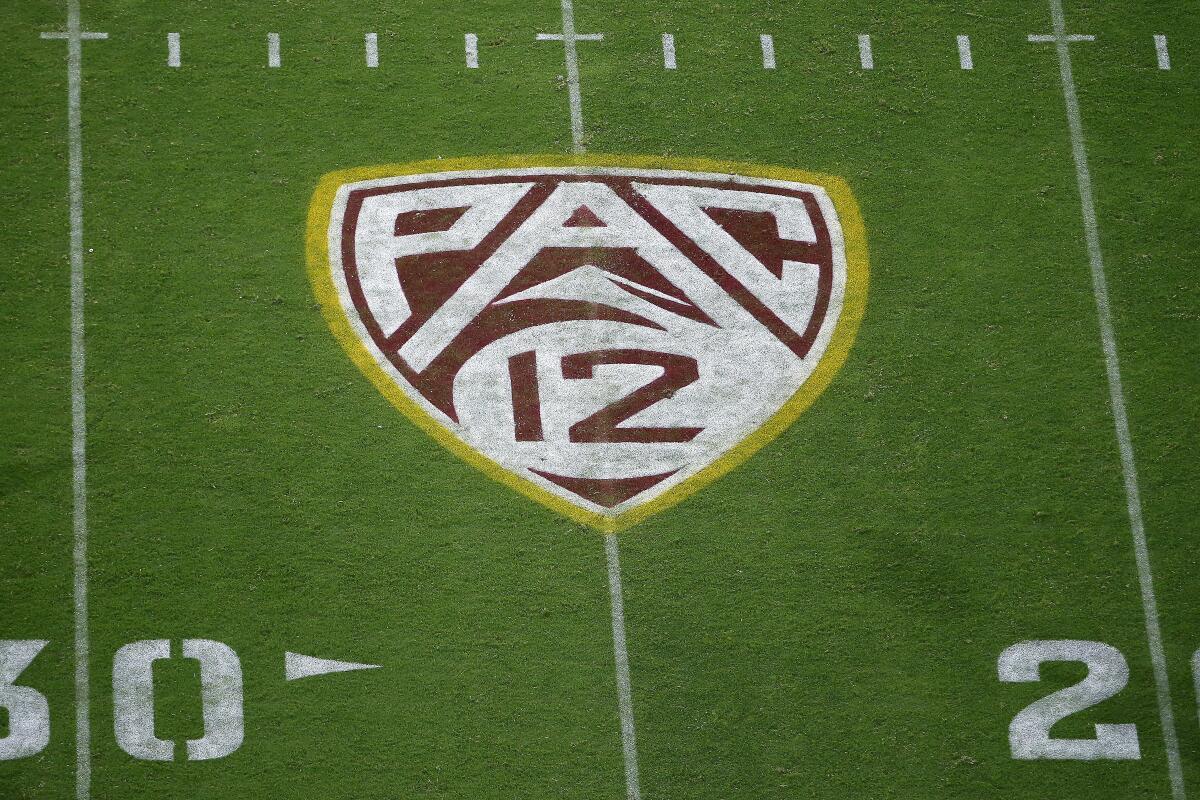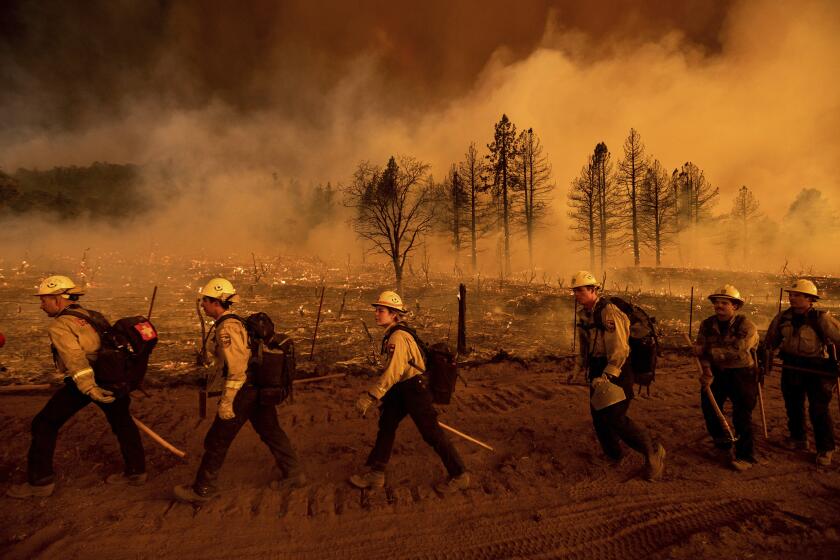Column: Longer flights, more climate pollution for college football teams

- Share via
When UCLA, UC Berkeley and Stanford ditched the fabled Pac-12 athletic conference, most college sports fans probably weren’t thinking about what the changes would mean for global warming.
Alas, most things mean something for global warming.
The breakup of the Pac-12, spurred by universities craving richer TV deals, has meant longer airplane trips for college athletes — and more heat-trapping carbon pollution from all that jet fuel. Pac-12 schools were once concentrated in the Western U.S. But UCLA left for the Big Ten, home mostly to Midwest and Northeast colleges. Berkeley and Stanford joined the Atlantic Coast Conference.
You're reading Boiling Point
Sammy Roth gets you up to speed on climate change, energy and the environment. Sign up to get it in your inbox twice a week.
You may occasionally receive promotional content from the Los Angeles Times.
It’s tough to know exactly how much each university’s carbon footprint expanded as a result.
But Payless Power, a Texas-based electric company that dabbles in data analysis, came up with estimates.
Payless focused on travel-related carbon dioxide emissions for college football teams in the “Power Four” major conferences, following the recent shake-ups. It found that between the 2023 and 2024 seasons, Stanford saw the biggest emissions increase of any team in any conference. UCLA had the biggest carbon footprint overall of any university football program, followed by Berkeley and Stanford.
None of this is to say that UCLA, Berkeley and Stanford are climate villains. Reducing emissions from air travel is notoriously difficult. I haven’t stopped flying, and I wouldn’t ask athletes to do so, especially considering that I’m a die-hard Dodgers fan. Watching last year’s Dodgers-Yankees World Series was a life highlight for me.
That said, I’m glad somebody is thinking about what the Power Four realignment means for the climate crisis. Because in 2025 — fresh off the hottest year ever measured — decision-makers at major companies, universities, government agencies and nonprofits should all be thinking about how their choices affect the climate.
“Every league and team that I work with are measuring or are planning to measure team travel-related [carbon] emissions. For those that aren’t, they certainly should be,” said Allen Hershkowitz, a scientist who co-founded the Green Sports Alliance and now works with organizations including the Clippers to limit climate pollution.
For most sports franchises, environmental initiatives have long focused on presenting a positive public image and saving money through efficiency — laudable goals. But I’d like to think sports executives will come to realize that leveraging their outsize cultural influence to drive climate progress is a business imperative. Because if they don’t, then ever-worsening wildfires, heat waves and storms will increasingly threaten their profit margins.
Take last fall’s Hurricane Milton. The powerful storm wrecked Tropicana Field, home to Major League Baseball’s Tampa Bay Rays, rendering the stadium unplayable for this season and possibly longer. Scientists estimate global warming probably caused the hurricane to hit Florida with at least 20% more rain and 10% stronger winds.

The Olympic Games have become a regular exercise in “winter athletes scrambling to find enough snow and their summertime counterparts facing health risks — cramping, vomiting, heat stroke,” as The Times’ David Wharton wrote last summer. A recent study from Queen’s University Belfast in Northern Ireland warned that athletes and fans in nearly 90% of 2026 World Cup host cities, including Los Angeles, could face “extreme heat risk.”
Research group Climate Central released an analysis last week, ahead of the Super Bowl, finding that the 30 cities with National Football League teams are experiencing 14 more extremely hot days, on average, than in 1970.
Speaking of the Super Bowl, the group Science Moms, which is led by climate scientists, paid for a 30-second ad that aired in L.A. and on streaming broadcasts during the Chiefs-Eagles game. The ad flashes through the lives of a series of young women, as the narrator, a scientist, laments how the planet will change around them.
“Our window to act on climate change is like watching them grow up. We blink and we miss it,” she says.
The ad ends with a call to donate to Los Angeles wildfire survivors at ScienceMoms.com.
Wildfires too pose a threat to sports, a point climate activists had hoped to make at a protest this week.
Oil company Phillips 66 was scheduled to be arraigned Wednesday in U.S. District Court in L.A. on charges that it violated the Clean Water Act by dumping oil and grease from its Carson refinery into the L.A. County sewer system. The local Sierra Club chapter had planned a rally outside the federal courthouse — the latest action in its campaign urging Dodgers owner Mark Walter to drop Phillips 66 gasoline brand 76 as a high-profile Dodger Stadium advertiser.
The rally was canceled after the arraignment was postponed. But organizer Lisa Kaas Boyle, who lost her home in the Palisades fire, noted in a news release that wildfire smoke has forced baseball teams to reschedule games.
“It’s almost becoming too hot to watch at Chavez Ravine,” Kaas Boyle said, referring to Dodger Stadium.

This is why the college football emissions analysis caught my attention. Not because Stanford students flying to North Carolina to play Duke are destroying the planet, but because people pay attention to sports. They listen to athletes, and coaches, and owners. If teams start taking climate change seriously, others might follow along.
Big universities were never going to choose athletic conferences based on carbon accounting. But I think it’s fair to ask them to acknowledge the climate side effects and do something in response, such as making investments to reduce emissions elsewhere or getting creative with scheduling to minimize air travel.
“It’s unfortunate if they can make easy changes to the schedule that would cut pollution, but choose not to,” said Seth Wynes, a professor focused on climate change mitigation at the University of Waterloo in Canada.
It’s difficult to say whether Stanford, UC Berkeley or UCLA are doing anything differently to cut pollution. Spokespeople for all three universities either didn’t respond to my requests for comment or declined to talk on the record.
I asked Wynes for his perspective on the Payless Power college football analysis. A few years ago, he authored a similar study finding that 2020 scheduling changes intended to limit air travel and reduce the spread of COVID-19 reduced carbon emissions across America’s four major men’s sports leagues by 26% per game.
Unlike Wynes’ study, the analysis conducted by Payless Power wasn’t peer-reviewed or published in an academic journal. Still, Wynes said in an email, the company’s methods “generally seem OK.” Payless Power assumed that teams traveling more than 250 miles were flying rather than traveling by bus, with flights producing 0.024 metric tons of carbon dioxide per mile. That’s broadly in line with the numbers Wynes used in his analysis, he said.
“The overall conclusion that conference realignment led to higher emissions is probably safe,” he said.
Again, cutting climate pollution from aviation isn’t easy. Electric passenger jets have struggled because batteries are so heavy. So-called sustainable aviation fuels can do only so much to reduce emissions. Also, when airlines offer to sell you carbon offsets, your dollars don’t actually go toward slashing emissions from your flight. They’re typically used to fund unrelated emissions-reduction projects, which may or may not actually work.
“In Europe and Australia ... much more is being done to encourage or require sports leagues and teams to travel by rail or otherwise modify their schedules,” Hershkowitz, who works with teams on climate, said in an email. “All sports organizations in North America, including colleges, would do well to learn from those initiatives.”
There’s more than enough money in sports to dedicate a bigger chunk to climate. If executives are following the science — and if they’re not too afraid of President Trump — they’ll do it because it’s good for them.
ONE MORE THING

This week’s Boiling Point podcast is also about sports and climate! Listen on Apple Podcasts, Spotify or YouTube as I talk with acclaimed climate activist Bill McKibben about “sportswashing,” which is basically the sports version of “greenwashing.” We discuss oil and gas industry advertising at Dodger Stadium and elsewhere.
This is the latest edition of Boiling Point, a newsletter about climate change and the environment in the American West. Sign up here to get it in your inbox. And listen to our Boiling Point podcast here.
For more climate and environment news, follow @Sammy_Roth on X and @sammyroth.bsky.social on Bluesky.
Toward a more sustainable California
Get Boiling Point, our newsletter exploring climate change, energy and the environment, and become part of the conversation — and the solution.
You may occasionally receive promotional content from the Los Angeles Times.




